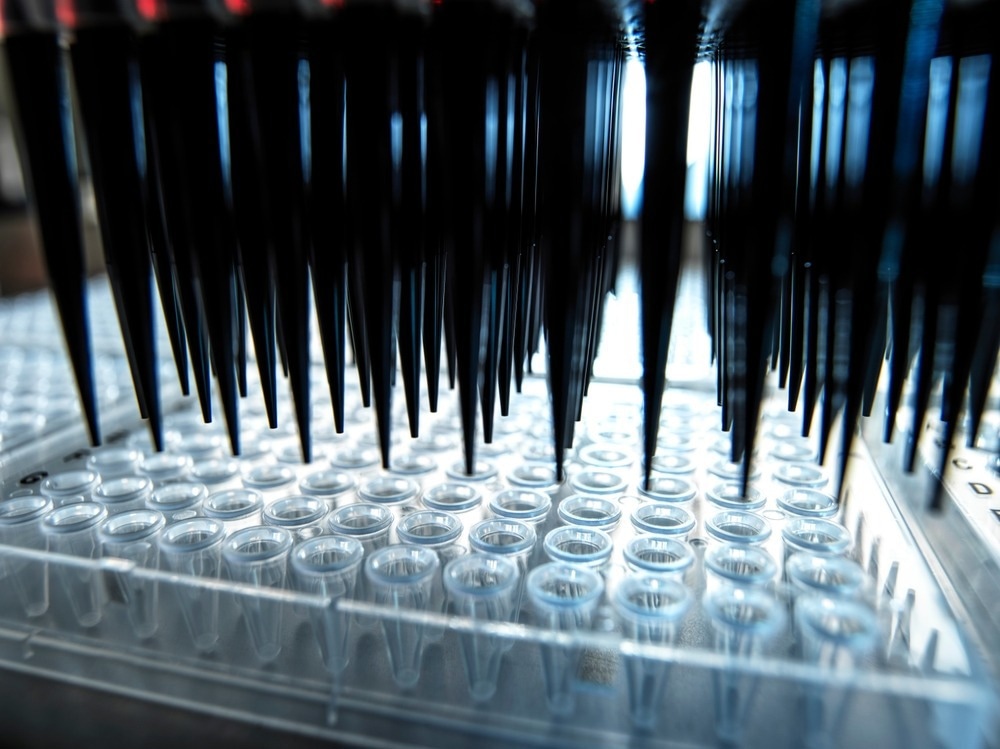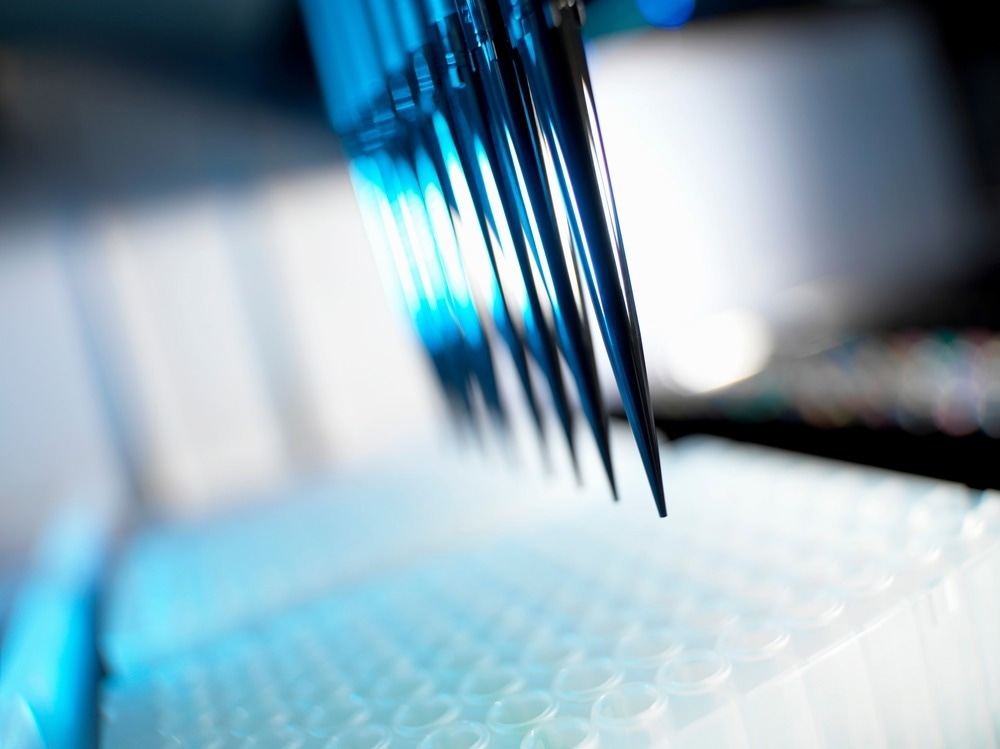It is well known that automated devices are a popular choice by industry to reduce manufacturing time, costs and risk. Now, some of these devices, including liquid handling equipment, has gained significant attention among academic researchers as well. Here, we discuss the contribution of automated liquid handling devices in scientific research.

Image Credit: Cavan-Images/Shutterstock.com
An Introduction to Automated Liquid Handling Strategy
Automated liquid handling devices are motorized pipettes or syringes attached to a robotic arm, which can dispense a specific volume of liquid to a designated container or tube.1 The integration of automation and robotics has enabled the development of automated liquid handling devices.2
Studies have shown that up to 89% of experimental steps within a protocol are associated with liquid manipulation and labware movement. These tasks can be easily performed via an automated platform. Many liquid manipulation steps required in experimental settings or laboratory analysis are associated with mixing, dilution, or inoculation. These steps can be accurately performed using an automated liquid handling strategy which offers higher precision and speed.3 The use of automated liquid handling devices leads to a significant increase in the performance of experiments per unit of time, independent of external factors.
The importance of liquid handling devices was significantly realized during the coronavirus disease 2019 (COVID-19) pandemic. During the initial stage of the pandemic, nationwide lockdowns and social distancing strategies were implemented to contain transmission of the severe acute respiratory syndrome coronavirus-2 (SARS-CoV-2) virus, the causal agent of the pandemic. These strategies significantly impacted scientific research. The use of automated liquid handling devices in remote labs helped scientists continue their experiments without being physically present near the instrument or experimental setup.4
Why Precision is so Important for Scientific Research?
Precision is extremely important in clinical research because it influences the reliability of the study findings. A well-defined study design, standardized data collection, accurate sample measurements, and liquid handling are important components of experimental precision.5 Experimental biases affect the integrity of the study findings.
In clinical research, precision is extremely important because it indicates the safety and effectiveness of treatments. It must also be noted that precise research findings play a crucial role in developing evidence-based guidelines that significantly help healthcare professionals in making informed decisions linked to treatment.6 The development of precise research protocols facilitates reproducibility, which can help other scientists validate the findings and enhance their applicability.

Image Credit: Image Source Trading Ltd/Shutterstock.com
Commercially Available Automated Liquid Handling Devices
Many companies commercially manufacture automated liquid handling devices, which range from simple to complex machines with varied levels of automation. These robotic devices can perform pre-programmed tasks accurately and with a greater speed, compared to traditional manually handled pipetting instruments. Typically, commercial manufacturers of automated liquid handling devices provide proprietary software linked with the system.3 The work designed to be performed by the robot is programmed by the operators in the software.
Tecan Group Ltd is a Swiss company that manufactures automated devices that can perform liquid handling tasks and move and store labware. Furthermore, this device comes with several modular attachments, such as magnetic separation, high throughput chromatography, and vacuum filtration.
A wide range of automated liquid handling robots are manufactured by Hamilton. The company claims that its liquid handling robots provide consistent and reliable results for many assays that require either low-throughput pipetting or high-throughput systems. This system provides great accuracy for pipetting workflow.
Agilent Technologies, Inc. has manufactured an automated system that can be integrated with other devices to perform multiple functions. For instance, a standalone liquid handler has been integrated with another device that enables the movement of Petri plates into a large storage space. Analytik Jena has offered a similar system where it integrated an independent liquid handling device with a carrier and plate storage.
The automated liquid handling devices manufactured by Gilson Inc. and Bio Molecular Systems have significantly reduced the time required to complete experimental protocols. Eppendorf is another company that has developed a smaller automated platform with multiple attachable applications including simple liquid-handling robots, next-generation sequencing, and DNA library preparation.
Automated liquid handling devices developed by PerkinElmer Inc. can transfer liquid between and across 384-well plates, and 96-well. INTEGRA Biosciences has manufactured a stand-alone electronic pipette that can be attached to a movable workbench for performing liquid handling tasks. The automated systems created by Qiagen and Singer Instrument Inc. can perform exceptional tasks of picking and plating microbial colonies, purification of DNA/RNA/protein, and so on.
Applications of Automated Liquid Handling in Scientific Research
At present, many companies have developed different types of automated liquid handling systems that are used in scientific research. Scientists have used automated tube labelers for high throughput purification. This device helps manipulate culture tubes for labeling using a Pick-and-Place (PnP) robotic arm.7 Commercially available liquid handling devices are also used to perform toxicological assays and purification of viral antigens.8,9
Tecan’s Freedom EVO has been used in many institutions for viral neutralization tests to determine the effectiveness of antibodies in neutralizing the SARS-CoV-2 virus. A COVID-19 testing laboratory used Tecan’s Fluent system that enabled the preparation of 14,000 samples per day for Reverse Transcriptase Polymerase Chain Reaction (RT-PCR) to analyze the virus.10
Automated liquid handling systems have also been used in labs that focus on the analysis of antibody levels after viral inoculation. They have also been used to handle DNA forensic samples. Furthermore, commercial liquid handling systems are also used to automate the preparation of libraries for spatial transcriptomic analysis.11
The main advantages of using these devices are precision, reproducibility, and reduced experimentation time. Relieving researchers from performing repetitive tasks offers them more time for creative work and data interpretation. Furthermore, these scientific instruments can perform tasks using lethal chemicals and organisms, thereby protecting operators from potential hazards.3
See More: The Power of Lab Automation in Diagnostics
References and Further Reading
- Cui, A. et al. (2013) Practical Considerations of Liquid Handling Devices in Drug Discovery. IntechOpen. doi.org/10.5772/52546
- Wu, T., & Zhou, Y. (2014) An Intelligent Automation Platform for Rapid Bioprocess Design. Journal of Laboratory Automation, 19(4), pp. 381-393.
- Torres-Acosta, M. A., et al. (2022) Automated liquid-handling operations for robust, resilient, and efficient bio-based laboratory practices. Biochemical Engineering Journal, 88, p. 108713.
- Zucchelli, P., et al. (2021) Highly Versatile Cloud-Based Automation Solution for the Remote Design and Execution of Experiment Protocols during the COVID-19 Pandemic. SLAS Technology, 26(2), pp. 127-139.
- Carlson, M. D., & Morrison, R. S. (2009) Study design, precision, and validity in observational studies. Journal of Palliative Medicine, 12(1), pp. 77-82.
- Johnson, K. B., et al. (2021) Precision Medicine, AI, and the Future of Personalized Health Care. Clinical and Translational Science, 14(1), pp. 86-93.
- Pan, J. Y., et al. (2021) An Automated Tube Labeler for High-Throughput Purification Laboratories. SLAS Technology, 26(1), pp. 113-116.
- Yang, Y. K., et al. (2021) Evaluate the comparability of two automated liquid handling systems for clinical toxicology assays. Drug Testing and Analysis, 13(2), pp. 404-411.
- Jacob, S. I., et al. (2021) High-Throughput Process Development for the Chromatographic Purification of Viral Antigens. In: Pfeifer, B.A., Hill, A. (eds) Vaccine Delivery Technology. Methods in Molecular Biology, vol 2183. Humana, New York, NY
- Krijger, P. H., et al. (2021) A public–private partnership model for COVID-19 diagnostics. Nature Biotechnology, 39(10), pp. 1182-1184.
- Berglund, E., et al. (2020) Automation of Spatial Transcriptomics library preparation to enable rapid and robust insights into spatial organization of tissues. BMC Genomics, 21, p. 298.
Disclaimer: The views expressed here are those of the author expressed in their private capacity and do not necessarily represent the views of AZoM.com Limited T/A AZoNetwork the owner and operator of this website. This disclaimer forms part of the Terms and conditions of use of this website.